Stars/Sun/Heliology
< Stars < SunHeliology is the science of Helios, Sol, otherwise known as the Sun.
Theoretical heliology
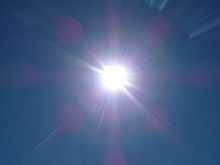
Def. the "scientific study of the Sun"[1] is called heliology.
Def. the "star at the center of the Solar System, represented in astronomy and astrology by ⨀"[2] is called the Sun.
Def. the "star that the Earth revolves around and from which it receives light and warmth.[3]"[4] is called the sun.
Neutrinos
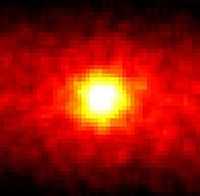
Gamma rays
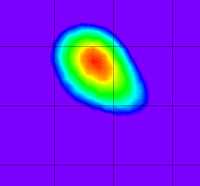
The Sun is seen in gamma rays by COMPTEL during a June 15, 1991, solar flare. The Sun is ordinarily not known to produce gamma rays, but during this solar flare, streams of neutrons poured into the intrastellar medium to create gamma rays. This image provided the first evidence that the Sun can accelerate particles for several hours. This phenomenon was not observed before CGRO and represents a new understanding of solar flares.
X-rays
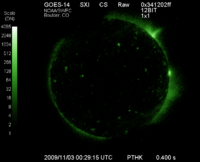
Visuals
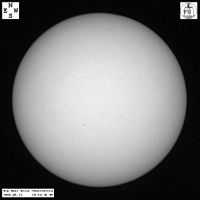
At the right is a visual image of the Sun.
Violets
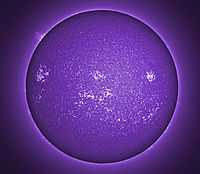
The image at the right is of the Sun using an H I violet band pass filter.
Blues
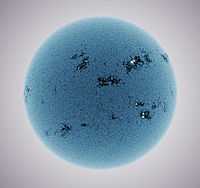
At the right is an image of the Sun through a Ca K extreme violet filter inverted through false color.
Yellows
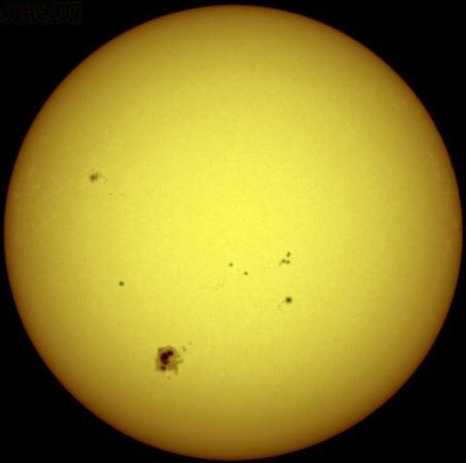
At the right is a visual image of the Sun with some sunspots visible. The two small spots in the middle have about the same diameter as our planet Earth.
Reds
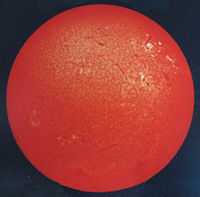
The image at right here is a red image taken through a solar telescope.
Infrareds
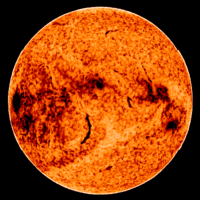
At the right is an infrared image of the Sun.
Radios
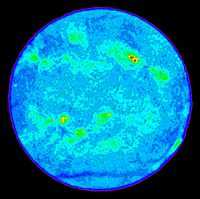
At right is a radio image of the Sun at 4.6 GHz. "The brightest discrete radio source is the Sun, but it is much less dominant than it is in visible light. The radio sky is always dark, even when the Sun is up, because atmospheric dust doesn't scatter radio waves, whose wavelengths are much longer than the dust particles."[5]
"The quiet Sun at 4.6 GHz imaged by the [Very Large Array] VLA with a resolution of 12 arcsec, or about 8400 km on the surface of the Sun. The brightest features (red) in this false-color image have brightness temperatures ~ 106 K and coincide with sunspots. The green features are cooler and show where the Sun's atmosphere is very dense. At this frequency the radio-emitting surface of the Sun has an average temperature of 3 x 104 K, and the dark blue features are cooler yet. The blue slash crossing the bottom of the disk is a feature called a filament channel, where the Sun's atmosphere is very thin: it marks the boundary of the South Pole of the Sun. The radio Sun is somewhat bigger than the optical Sun: the solar limb (the edge of the disk) in this image is about 20000 km above the optical limb."[5]
Hydrogen
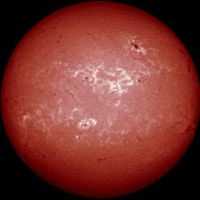
Research
Hypothesis:
- Helios was an early name for Saturn, or a former Saturn entity.
Control groups

The findings demonstrate a statistically systematic change from the status quo or the control group.
“In the design of experiments, treatments [or special properties or characteristics] are applied to [or observed in] experimental units in the treatment group(s).[6] In comparative experiments, members of the complementary group, the control group, receive either no treatment or a standard treatment.[7]"[8]
Proof of concept
Def. a “short and/or incomplete realization of a certain method or idea to demonstrate its feasibility"[9] is called a proof of concept.
Def. evidence that demonstrates that a concept is possible is called proof of concept.
The proof-of-concept structure consists of
- background,
- procedures,
- findings, and
- interpretation.[10]
See also
References
- ↑ "heliology, In: Wiktionary". San Francisco, California: Wikimedia Foundation, Inc. 2 June 2014. Retrieved 2014-08-02.
- ↑ "Sun, In: Wiktionary". San Francisco, California: Wikimedia Foundation, Inc. 21 June 2014. Retrieved 2014-08-02.
- ↑ The Illustrated Oxford Dictionary, Oxford University Press, 1998
- ↑ "the sun, In: Wiktionary". San Francisco, California: Wikimedia Foundation, Inc. 21 June 2014. Retrieved 2014-08-02.
- 1 2 S.G. Djorgovski et al. "A Tour of the Radio Universe". National Radio Astronomy Observatory. Retrieved 2014-03-16.
- ↑ Klaus Hinkelmann, Oscar Kempthorne (2008). Design and Analysis of Experiments, Volume I: Introduction to Experimental Design (2nd ed.). Wiley. ISBN 978-0-471-72756-9. http://books.google.com/?id=T3wWj2kVYZgC&printsec=frontcover.
- ↑ R. A. Bailey (2008). Design of comparative experiments. Cambridge University Press. ISBN 978-0-521-68357-9. http://www.cambridge.org/uk/catalogue/catalogue.asp?isbn=9780521683579.
- ↑ "Treatment and control groups, In: Wikipedia". San Francisco, California: Wikimedia Foundation, Inc. May 18, 2012. Retrieved 2012-05-31.
- ↑ "proof of concept, In: Wiktionary". San Francisco, California: Wikimedia Foundation, Inc. November 10, 2012. Retrieved 2013-01-13.
- ↑ Ginger Lehrman and Ian B Hogue, Sarah Palmer, Cheryl Jennings, Celsa A Spina, Ann Wiegand, Alan L Landay, Robert W Coombs, Douglas D Richman, John W Mellors, John M Coffin, Ronald J Bosch, David M Margolis (August 13, 2005). "Depletion of latent HIV-1 infection in vivo: a proof-of-concept study". Lancet 366 (9485): 549-55. doi:10.1016/S0140-6736(05)67098-5. http://www.ncbi.nlm.nih.gov/pmc/articles/PMC1894952/. Retrieved 2012-05-09.
Further reading
- S.G. Djorgovski et al. "A Tour of the Radio Universe". National Radio Astronomy Observatory. Retrieved 2014-03-16.
External links
- African Journals Online
- Bing Advanced search
- Google Books
- Google scholar Advanced Scholar Search
- International Astronomical Union
- JSTOR
- Lycos search
- NASA/IPAC Extragalactic Database - NED
- NASA's National Space Science Data Center
- Office of Scientific & Technical Information
- PubChem Public Chemical Database
- Questia - The Online Library of Books and Journals
- SAGE journals online
- The SAO/NASA Astrophysics Data System
- Scirus for scientific information only advanced search
- SDSS Quick Look tool: SkyServer
- SIMBAD Astronomical Database
- SIMBAD Web interface, Harvard alternate
- Spacecraft Query at NASA.
- SpringerLink
- Taylor & Francis Online
- Universal coordinate converter
- Wiley Online Library Advanced Search
- Yahoo Advanced Web Search
| ||||||||||||||||||||||||||||||||
| |||||||||||||||||||||||||||||||||||
![]() This is a research project at http://en.wikiversity.org
This is a research project at http://en.wikiversity.org
| |
Development status: this resource is experimental in nature. |
| |
Educational level: this is a research resource. |
| |
Resource type: this resource is an article. |
| |
Resource type: this resource contains a lecture or lecture notes. |
| |
Subject classification: this is an astronomy resource. |